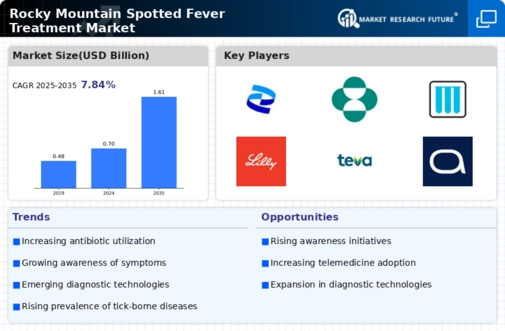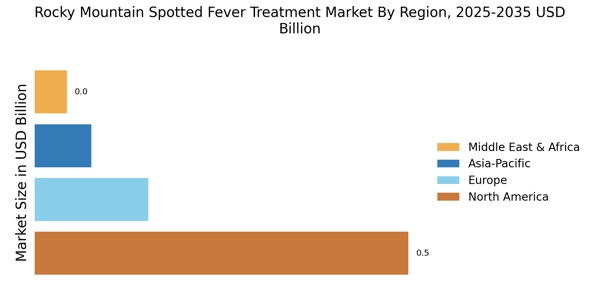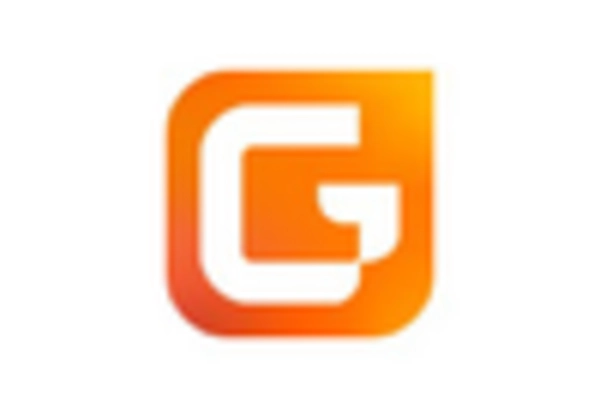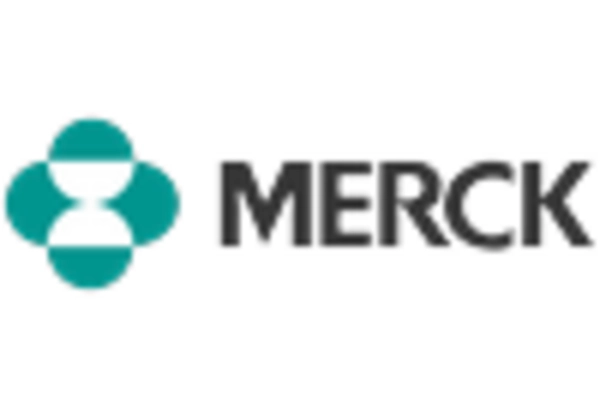Growing Public Health Initiatives
Growing public health initiatives aimed at controlling tick populations and educating communities about RMSF are influencing the Rocky Mountain Spotted Fever Treatment Market. Public health campaigns that focus on prevention strategies, such as tick avoidance and awareness of RMSF symptoms, are essential in reducing the incidence of the disease. These initiatives not only aim to lower the number of new cases but also emphasize the importance of timely treatment for those affected. As communities become more informed, the demand for effective treatment options is likely to increase. Furthermore, government agencies and non-profit organizations are actively involved in funding research and awareness programs, which could lead to advancements in treatment methodologies. This collaborative effort between public health entities and the pharmaceutical industry may create a more favorable environment for the growth of the RMSF treatment market.
Technological Advancements in Diagnostics
Technological advancements in diagnostic methods are significantly influencing the Rocky Mountain Spotted Fever Treatment Market. Enhanced diagnostic tools, such as polymerase chain reaction (PCR) tests and serological assays, allow for quicker and more accurate identification of RMSF. This rapid diagnosis is crucial, as timely treatment can prevent severe complications associated with the disease. The integration of advanced technologies in clinical settings is likely to improve patient outcomes and increase the demand for effective treatment options. Furthermore, as diagnostic capabilities expand, healthcare providers may be more inclined to initiate treatment earlier, thereby driving market growth. The ongoing development of innovative diagnostic solutions suggests a promising future for the RMSF treatment market, as it aligns with the need for efficient healthcare delivery.
Regulatory Support for Treatment Approvals
Regulatory support for the approval of new treatments is a crucial driver for the Rocky Mountain Spotted Fever Treatment Market. Regulatory agencies are increasingly recognizing the need for effective therapies to address RMSF, which has led to streamlined approval processes for promising drug candidates. This supportive regulatory environment encourages pharmaceutical companies to invest in the development of innovative treatments. Additionally, expedited review pathways for drugs targeting rare diseases may facilitate quicker access to effective therapies for patients suffering from RMSF. As regulatory frameworks evolve to accommodate the unique challenges associated with tick-borne illnesses, the market is likely to experience a surge in new treatment options. This trend indicates a proactive approach to addressing the healthcare needs of individuals affected by RMSF, ultimately benefiting the treatment landscape.
Increased Investment in Research and Development
Increased investment in research and development (R&D) is a significant driver for the Rocky Mountain Spotted Fever Treatment Market. Pharmaceutical companies are recognizing the need for effective treatments and are allocating substantial resources towards the development of new therapies. This trend is particularly evident in the context of emerging drug candidates and novel therapeutic approaches aimed at combating RMSF. The potential for lucrative returns on investment in this niche market encourages companies to innovate and expand their product portfolios. Additionally, collaborations between academic institutions and industry players are likely to foster breakthroughs in treatment methodologies. As R&D efforts intensify, the market is expected to witness the introduction of advanced treatment options, thereby enhancing the overall landscape of RMSF management.
Rising Incidence of Rocky Mountain Spotted Fever
The increasing incidence of Rocky Mountain Spotted Fever (RMSF) is a primary driver for the Rocky Mountain Spotted Fever Treatment Market. As reported by the Centers for Disease Control and Prevention, the number of RMSF cases has shown a notable rise in recent years, particularly in certain regions. This uptick in cases necessitates effective treatment options, thereby propelling market growth. The heightened awareness among healthcare professionals and the public regarding RMSF symptoms and transmission routes further contributes to the demand for treatment solutions. Consequently, pharmaceutical companies are likely to invest in research and development to create innovative therapies, which could enhance the overall treatment landscape. This trend indicates a robust market potential for RMSF treatments, as healthcare systems strive to address the growing burden of this tick-borne illness.


















Leave a Comment